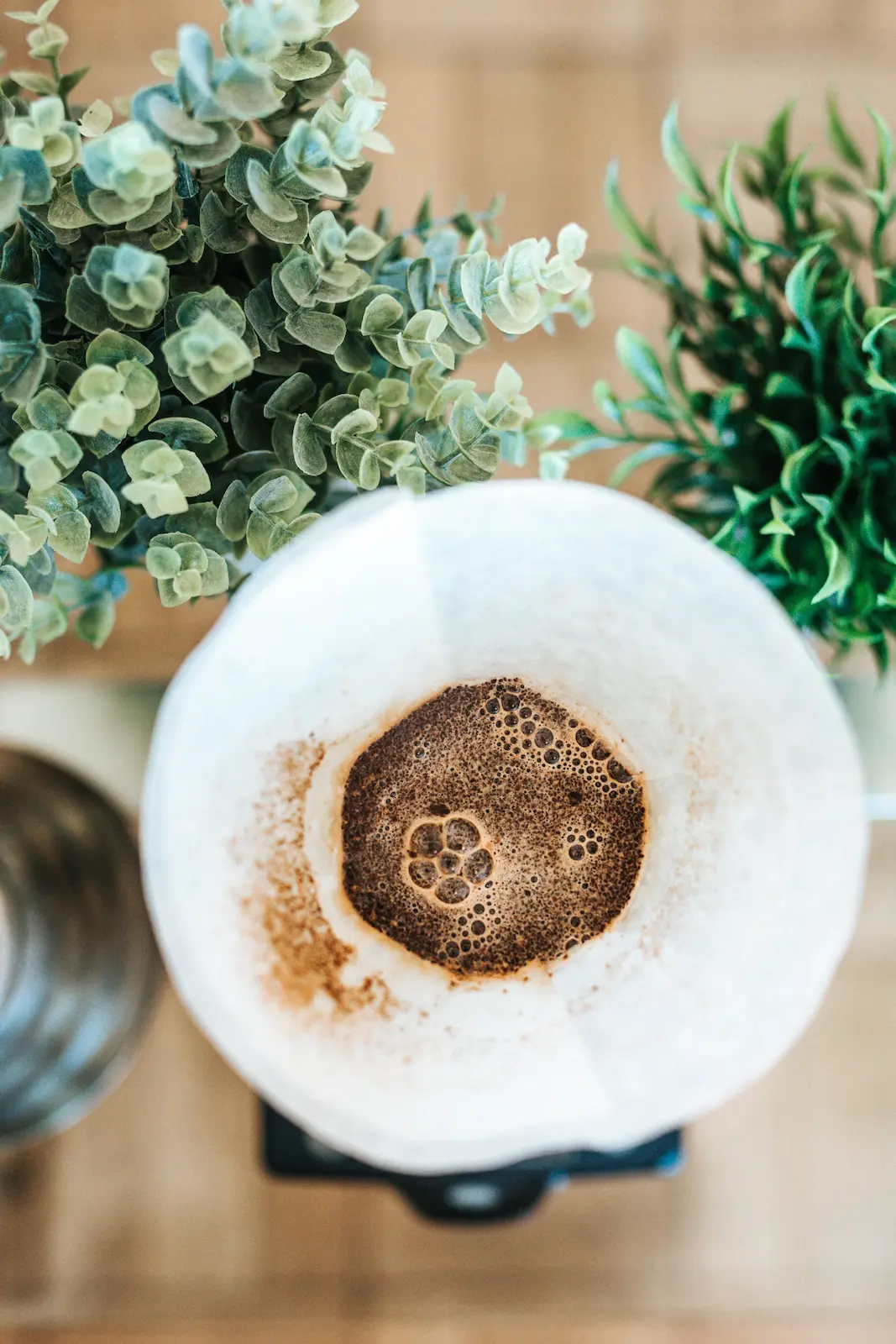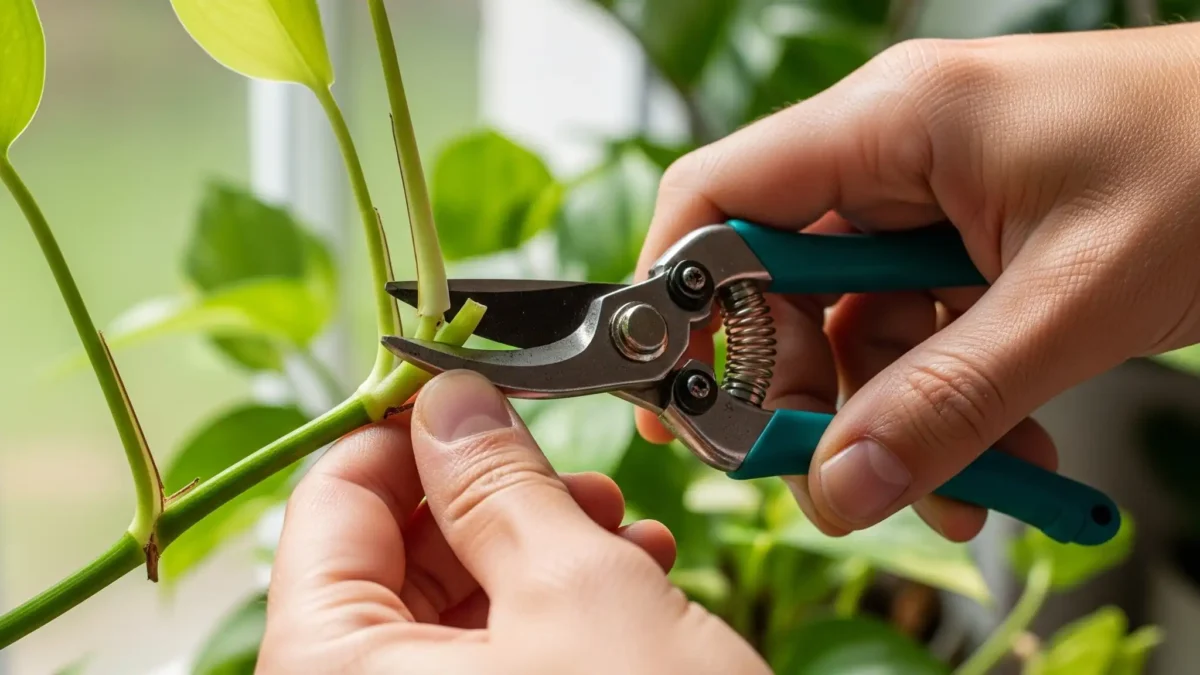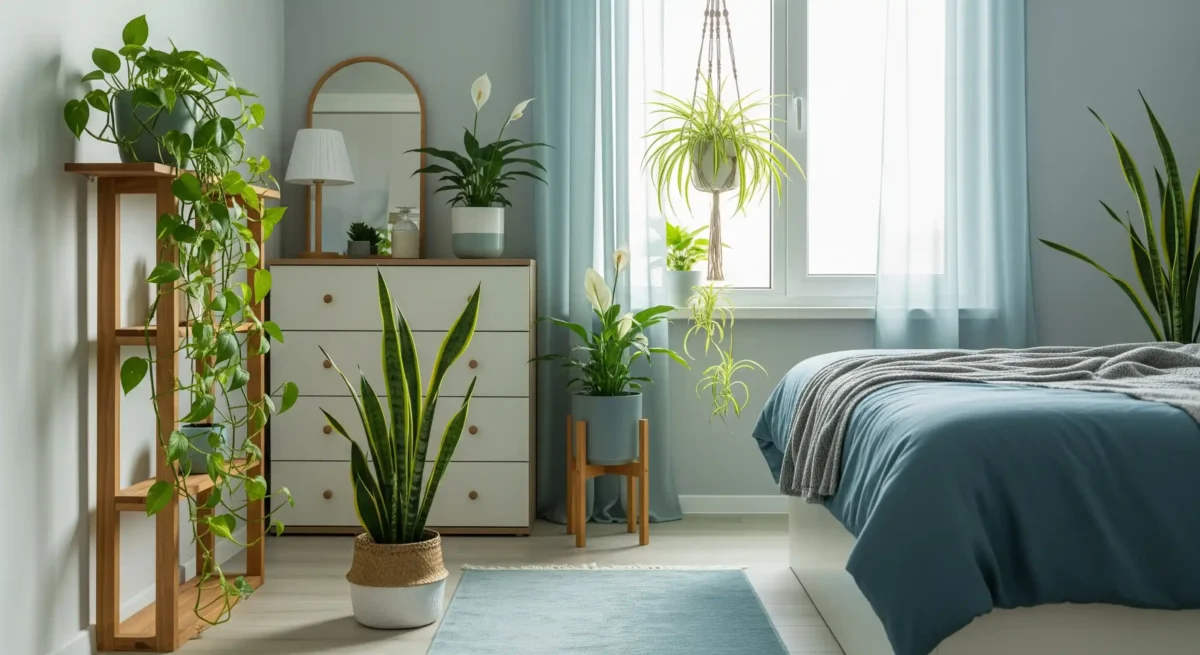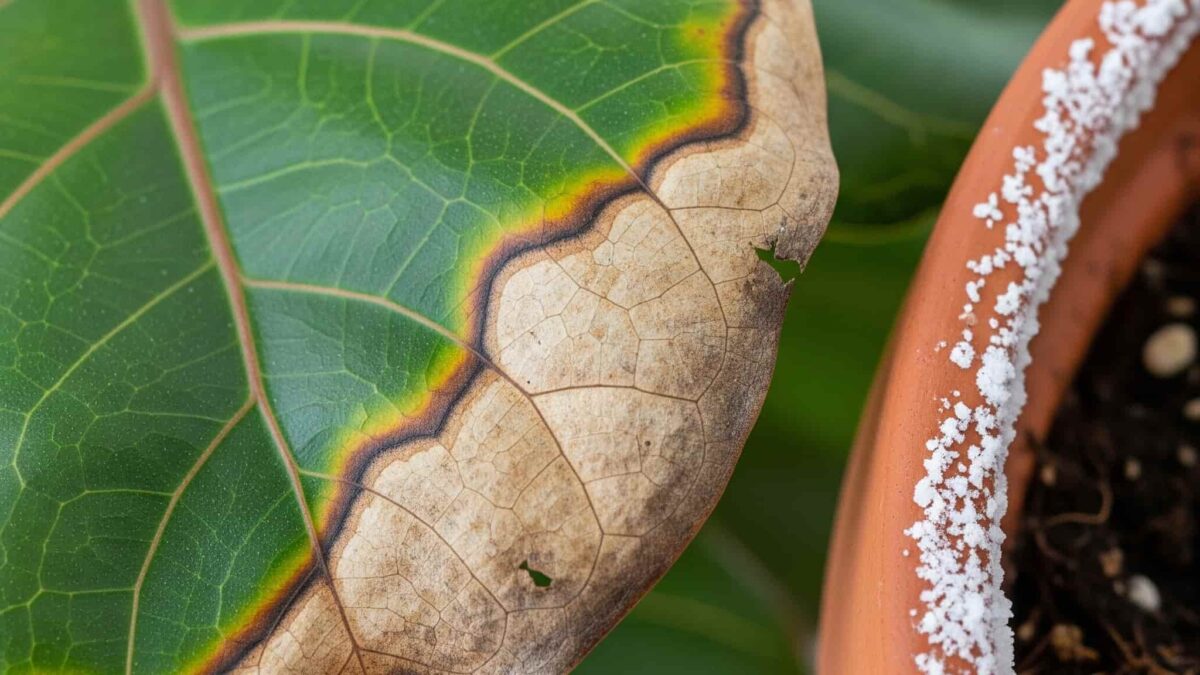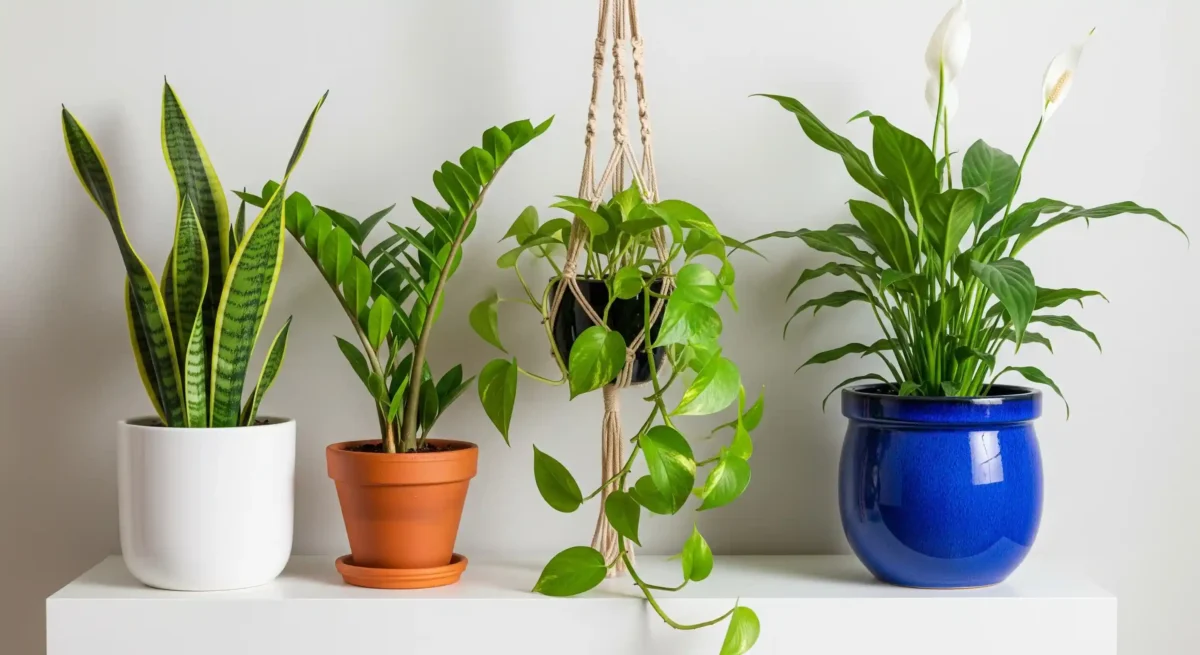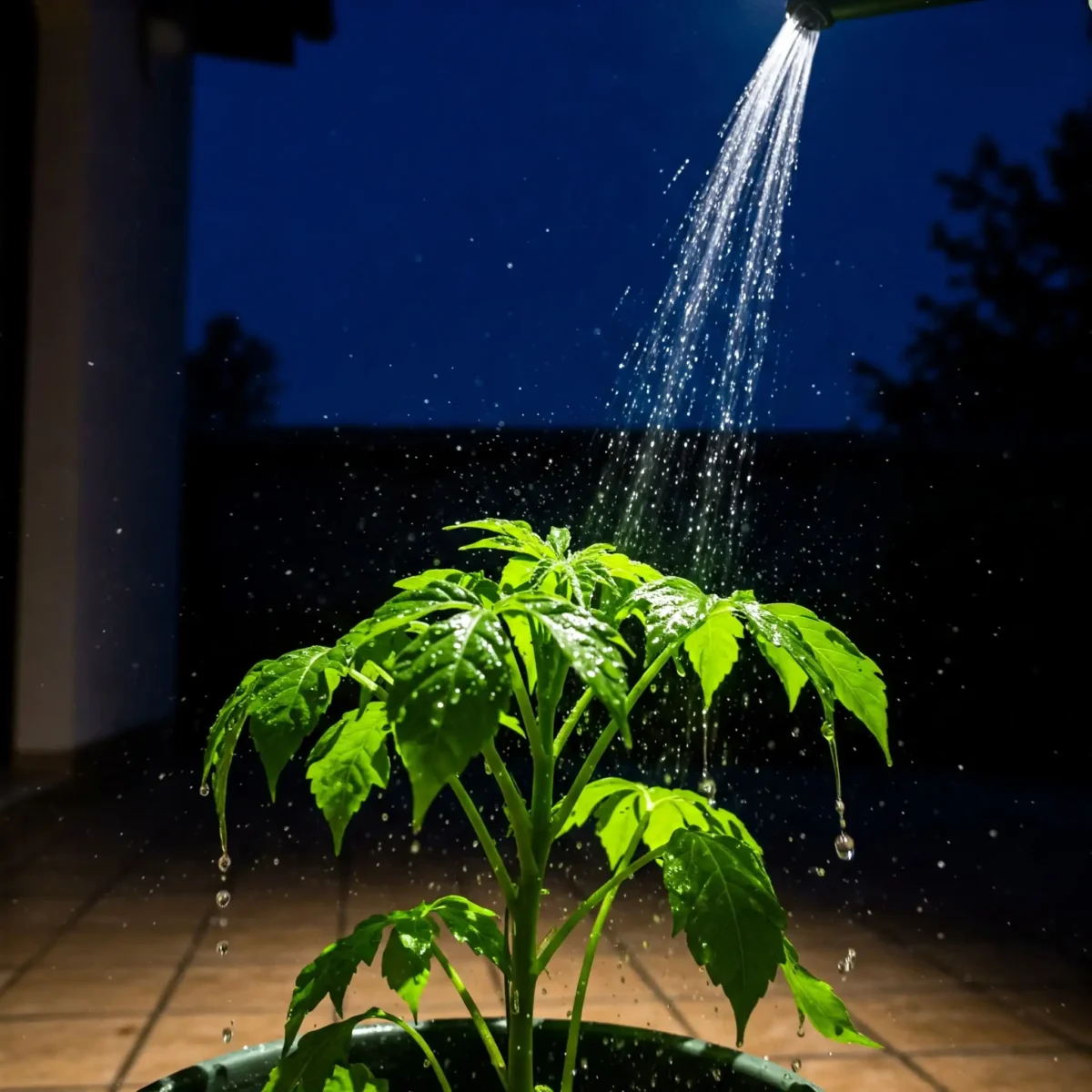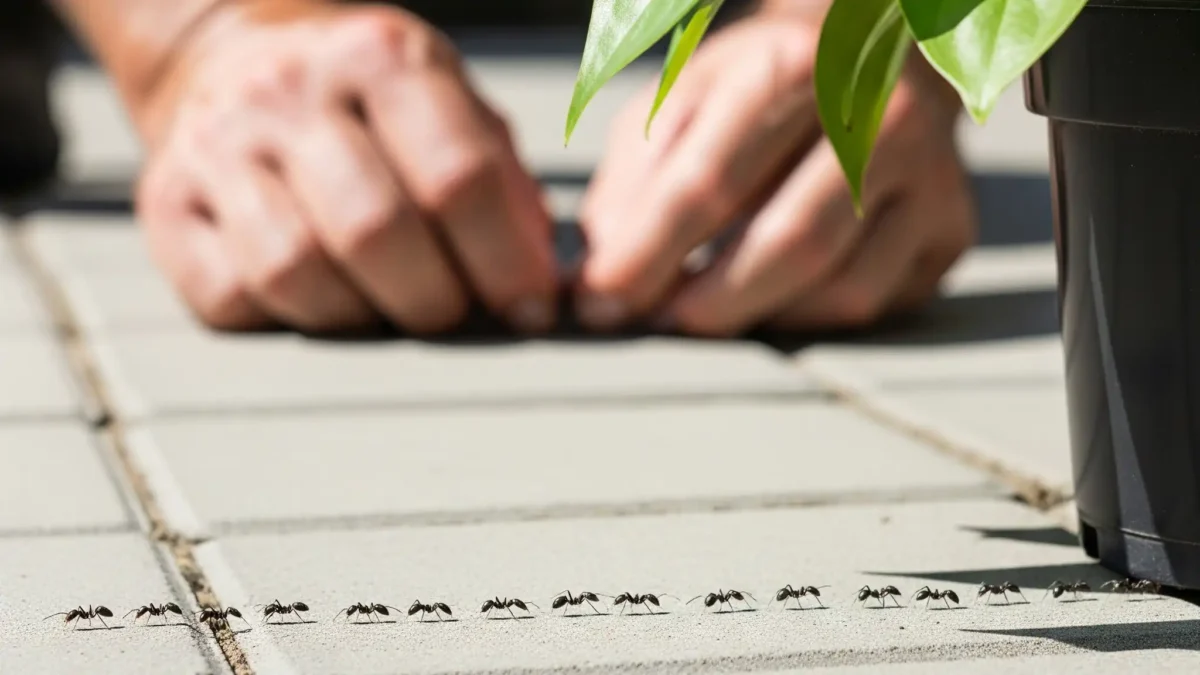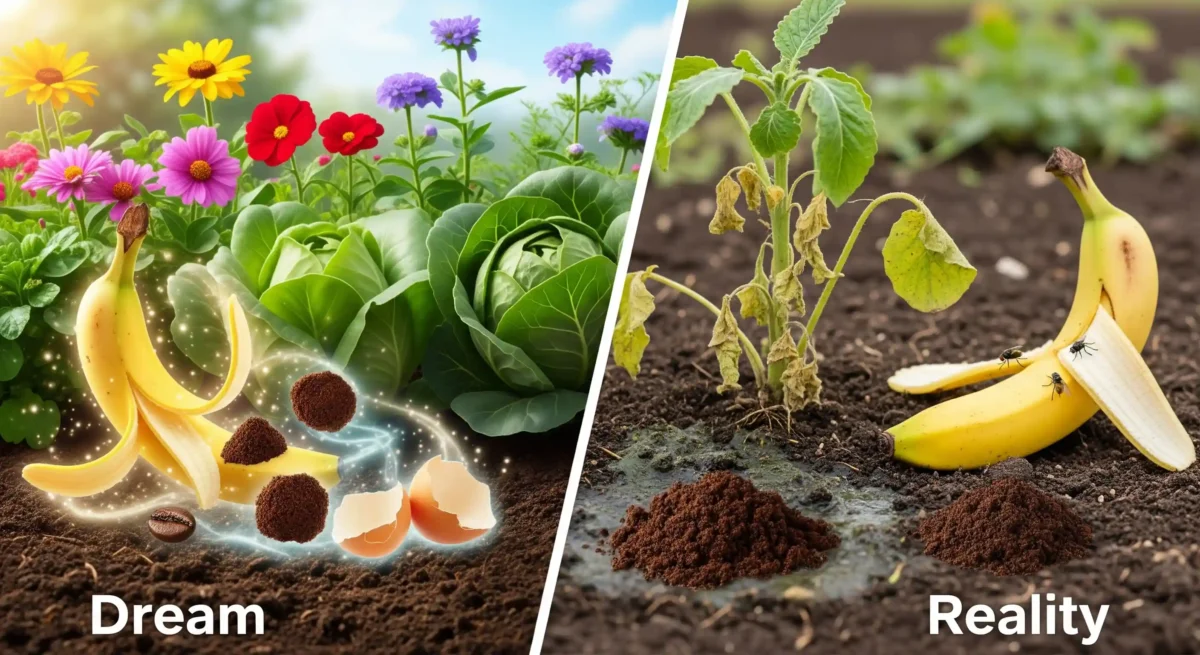Your Ultimate Guide to the Best Pet-Friendly (Non-Toxic) Houseplants: Pawsitively Green & Perfectly Safe!
Do you love the notion of having a lush indoor jungle but are worried that your curious cat or active dog would eat something they shouldn’t? You’re in the right spot! As pet parents, our number one responsibility is keeping our furry friends safe. But that doesn’t mean you have to give up your dreams of a home full of plants. People often ask me, “How can I have beautiful plants and keep my pets safe?”
Don’t worry; this article is all about showing you the best pet-friendly (non-toxic) houseplants. This way, you can enjoy the beauty and many advantages of indoor plants without worrying about your pets. In a house with pets, it’s quite important to pick plants that aren’t poisonous. After all, our furry companions use their tongues and paws to explore the environment! So, let’s find a whole world of gorgeous, safe plants that you and your pets will love. Get ready to make your space greener without feeling bad!
Why “Pet-Friendly” Matters: Knowing How Plants Can Be Poisonous to Your Pets
Before we get to the fun part of choosing your new green friends, let’s talk about why “pet-friendly” is so important. Unfortunately, many common and very beautiful houseplants have chemicals in them that might be bad for our pets if they eat them. The reactions can be as modest as a stomach ache or skin irritation or as serious as needing to see a vet. And what about our pets? It’s in their nature to be curious! A cat might think that a leaf hanging down looks like a new toy, while a dog might think that a recently planted plant is a fun place to dig. Pets often chew, swat, bat, and even taste things.
The ASPCA (American Society for the Prevention of Cruelty to Animals) has great lists of plants that are safe and plants that are not safe, but it can be hard to go through them all. This guide will help you with that! We have put together a list of beautiful, frequently easy-to-care-for, and most importantly, safe solutions. The good news is that there are so many beautiful and safe plants out there that you’ll have a hard time choosing!
Now that we know the “why,” let’s get to the fun part: the “what”! Which beautiful green friends may you bring home without worrying?
Our Favorite Indoor Plants That Are Safe and Stylish for Homes with Pets
Get ready to meet some lovely plants that are also safe! I choose a mix of plants, some that trail, some that stand tall, others with interesting textures, and even one that blooms. I’ll tell you why each one is a pet parent’s dream and how to keep it alive.
Chlorophytum comosum, the spider plant
Say hello to the Spider Plant, a classic beauty that looks great and is safe for your cat. It has arching leaves and cute small “spiderettes” (baby plantlets) that hang down like little chandeliers. That’s why it’s a classic.
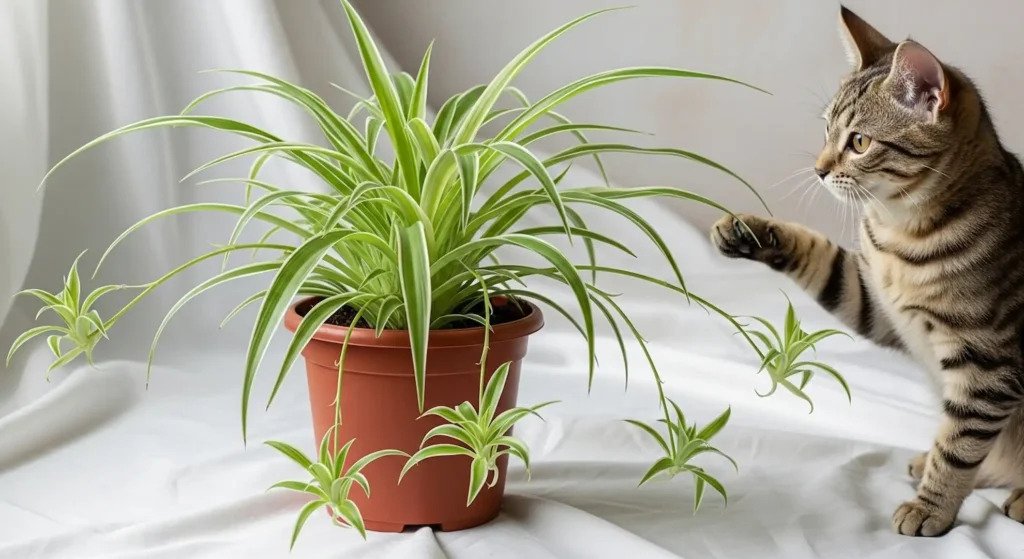
- Why It’s a Good Plant for Pet Owners: First of all, Spider Plants are safe for cats and dogs. A lot of cats are quite interested in the dangling plantlets and will often bat at them like they are toys. They are also great at cleaning the air and are quite easy to take care of.
- Light Needs Made Simple: These guys like strong, indirect light, but they can also handle lower light levels. Just stay away from harsh, direct sunlight, which can burn their leaves.
- Watering Wisdom (The Don’t-Panic Guide): When the top inch or two of soil seems dry, give it a good soak. It’s okay if you forget to water your spider plants every once in a while. If your tap water has a lot of minerals in it or if the air is really dry, the tips of the leaves may turn brown. This is usually simply a cosmetic problem.
- Soil and Potting Tips: A nice potting mix that drains properly will keep it happy. Check to see if your pot has holes for drainage.
- Fun Facts and Tips for Styling: You can easily cut off those spiderettes and grow new Spider Plants in water or soil. Give them to your pals! They look great in hanging baskets or on shelves where their babies can fall down.
- Quick Keywords: Spider Plant pet safe, non-toxic Spider Plant, Spider Plant care, Spider Plant for cats, and Spider Plant for dogs.
Haworthia Zebra (Haworthiopsis attenuata or Haworthia fasciata)
Want a stylish succulent that won’t hurt your pets? Meet the Haworthia Zebra! The dark green leaves have white, uneven stripes on them that make it look incredibly cool and like a building.
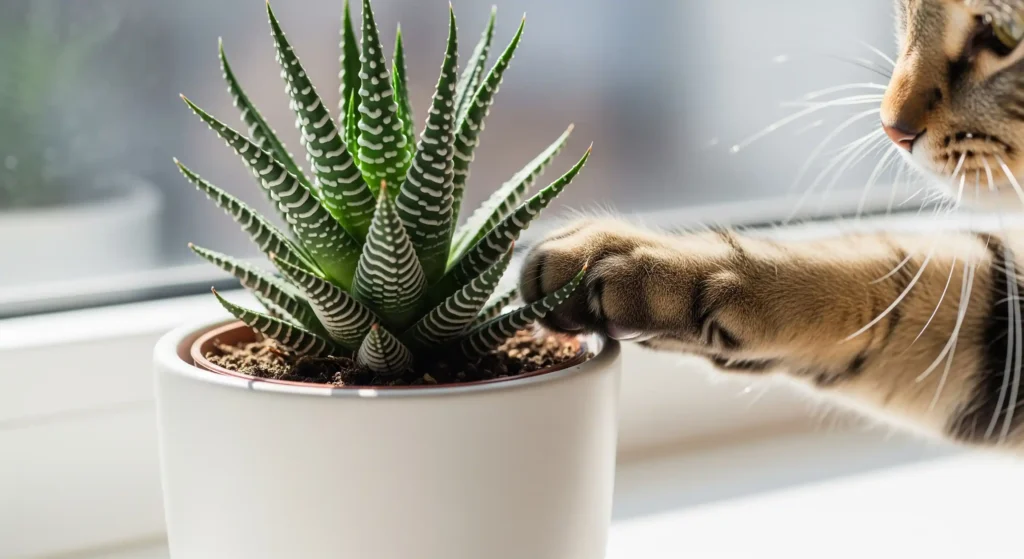
- Why It’s a Pet Parent’s Friend: This small succulent is safe for both cats and dogs, so it’s a great choice for sunny windowsills where pets might want to check it out. It’s little, grows slowly, and doesn’t need much care.
- Light Needs Made Easy: Haworthias like bright, indirect light. They can handle some direct morning sun, but severe afternoon sun can make their color fade or possibly burn them.
- Watering Wisdom (The Don’t-Panic Guide): Haworthias, like most succulents, can live without water for a long time. Only water it well when the earth is fully dry, and then let it dry out again. The biggest threat to it is too much water. You can water even less in the winter.
- Soil and Potting Tips: Use a cactus or succulent mix that drains quickly. You need a pot that drains well.
- Fun Facts and Styling Tips: These little plants are great for small areas, terrariums (but make sure they have sufficient airflow if they’re closed), or mixed succulent arrangements (with other pet-safe types, of course!). Their texture is very interesting.
- Quick Keywords: Haworthia Zebra is safe for pets, non-toxic, and easy to care for.
Nephrolepis exaltata, the Boston fern
The Boston Fern is a great choice if you want some soft, green foliage. Its gently arching fronds may make any place feel more like a calm retreat.
- Why It’s a Good Thing for Pet Owners: Good News! Boston ferns are safe for cats and dogs. You don’t have to worry if your cat thinks a frond looks like a fun new toy. They are also recognized for cleaning the air very well.
- Light Needs Made Easy: These ferns do best in bright, indirect light and like it when the air is damp. Find a place near a bathroom window or in the kitchen where there is good light. The delicate fronds will burn in direct sunlight.
- Watering Wisdom (The Don’t-Panic Guide): Boston Ferns need their soil to be damp but not waterlogged. Don’t let them dry out all the way. They enjoy high humidity, so misting them often or putting them on a pebble tray with water can assist.
- Soil and Potting Tips: Use a potting mix that is rich, drains well, and keeps some moisture.
- Fun Facts and Tips for Styling: Their traditional, elegant design makes them great for pedestals, hanging baskets, or just to lend a gentle touch to a corner of a space. They do drop little leaves from time to time, so be ready to clean up a little bit.
- Quick Keywords: Boston Fern pet safe, non-toxic Boston Fern, Boston Fern care, and pet friendly ferns.
The Prayer Plant (Maranta leuconeura)
The Prayer Plant is a real stunner since its leaves are wonderfully patterned and fold up at night to look like praying hands. The detailed patterns in green, red, and cream are just beautiful.
- Why It’s a Pet Parent’s Friend: You can enjoy its beauty without worrying because the Prayer Plant is safe for cats and dogs. Its interesting leaf movements can also be fun to watch for pets and people who are paying attention.
- Light Needs Made Easy: Prayer plants like medium to bright, indirect light. If they get too much direct sunlight, their bright colors may fade and their leaves may burn. They can handle less light, but their colors might not be as bright.
- Watering Wisdom (The Don’t-Panic Guide): During the growing season (spring and summer), make sure the soil is always moist but not too wet. Let the top inch dry out a little bit between waterings. They like it when the air is very humid, so misting or using a humidifier will help.
- Soil and Potting Tips: A peat-based potting mix that drains properly works nicely.
- Fun Facts and Styling Tips: One interesting thing about them is that their leaves move every day (nyctinasty). They are very little, so they work well on tabletops or shelves where you can get a good look at their beautiful leaves.
- Quick Keywords: Prayer Plant pet safe, non-toxic Maranta, Prayer Plant care, and Maranta leuconeura for pets.
The Rattlesnake Plant is also known as Calathea lancifolia.
The Rattlesnake Plant is a member of the Calathea family, which includes many plants that are suitable for pets. Its leaves are tall and wavy, with dark green spots on top and rich purple spots on the bottom. It really gets people’s attention!
- Why It’s a Pet Parent’s Friend: The Rattlesnake Plant is safe for cats and dogs, just like its cousin the Prayer Plant. People often call calatheas “living art” because of their beautiful leaves, and this one is no different.
- Light Needs Made Easy: Give it medium to bright, indirect light. Direct sunlight will burn the leaves, so don’t do it. They can grow in less light, although it can take longer.
- Watering Wisdom (The Don’t-Panic Guide): Calatheas like their soil to be moist but not waterlogged. They don’t like it when they dry out totally. They need a lot of humidity to look their best. You can use pebble trays, humidifiers, or put them among other plants to do this. Brown leaf tips can happen when plants are susceptible to minerals in tap water. Using filtered or distilled water can help keep them from happening.
- Tips for Soil and Potting: A potting mix that is light, porous, and drains well is best.
- Styling Tips and Fun Facts: The bottoms of the leaves are just as pretty as the tops! Calatheas, like Prayer Plants, also move their leaves, but not as drastically. When they are fully grown, they make a beautiful floor plant or a statement item on a table because they grow straight up.
- Quick Keywords: Rattlesnake Plant is safe for pets, Calathea is non-toxic, Calathea lancifolia care, and Calathea is pet-friendly.
The Areca Palm (Dypsis lutescens)
Want to add a tropical feel to your home? The Areca Palm’s airy, arching fronds can make your home feel like a resort right away.
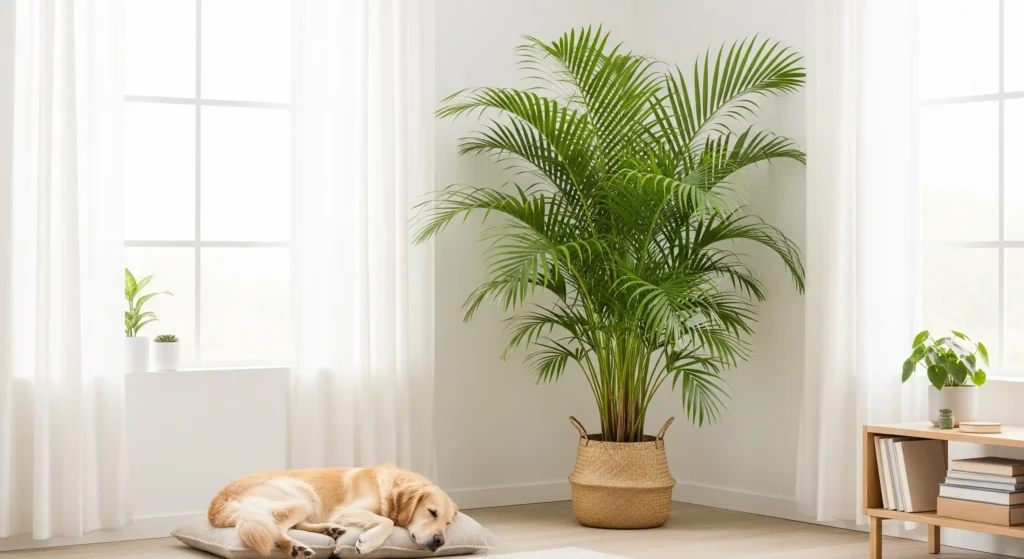
- Why It’s a Pet Parent’s Pal: This beautiful palm is safe for both cats and dogs, so you can enjoy its beauty without worry. It is also a well-known way to clean the air.
- Light Needs Made Easy: Areca Palms like bright, indirect light. Their fronds can get burned if they get too much direct sunlight, and they can develop weakly if they don’t get enough light.
- Watering Wisdom (The Don’t-Panic Guide): When the top inch or two of soil seems dry, give it a good soak. They don’t like it when the soil is too dry or too wet. It’s important to have good drainage. They also like it when it’s humid.
- Tips for soil and potting: Use a potting mix that drains well and is made of peat.
- Fun Facts and Styling Tips: Areca Palms may get very big, which makes them great floor plants for filling up a bright space. They look large and luscious because they have many stems. Cats like to bat at the lower fronds sometimes!
- Quick Keywords: Areca Palm pet safe, non-toxic Areca Palm, Dypsis lutescens care, and pet-friendly palm trees.
Pachira aquatica, or the Money Tree
The Money Tree is a popular and beautiful houseplant with unique, hand-shaped leaves. People often braid them together and think they would bring good luck and wealth.
- Why It’s a Pet Parent’s Friend: The real Money Tree (Pachira aquatica) is safe for cats and dogs, which is why it’s a pet owner’s best friend. It’s vital to make sure you have this exact type because other plants are frequently labeled “money plants” and can be poisonous.
- Light Needs Made Easy: Money trees do best in medium to bright, indirect light. They can handle some lower light, but they might get a little lanky. Stay out of direct, strong sunlight.
- Watering Wisdom (The Don’t-Panic Guide): When the top 1 to 2 inches of soil are dry, water it well. They like to dry out a little bit between waterings, but if you water them too much, their roots can rot.
- Soil and potting tips: You need a potting mix that drains effectively. A lot of them have a braided trunk, which is a nice touch.
- Fun Facts and Styling Tips: Money Trees are not only attractive foliage plants, but they also have good luck stories. You can cultivate them as small plants for your table or let them grow into big plants for your floor.
- Quick Keywords: Money Tree is safe for pets, Pachira aquatica is non-toxic, and Pachira aquatica care is easy.
African Violet (Saintpaulia ionantha)
The African Violet is a lovely and pet-safe alternative if you want a splash of color and some pretty flowers. These small plants have soft leaves and groups of flowers that come in purple, pink, blue, or white.
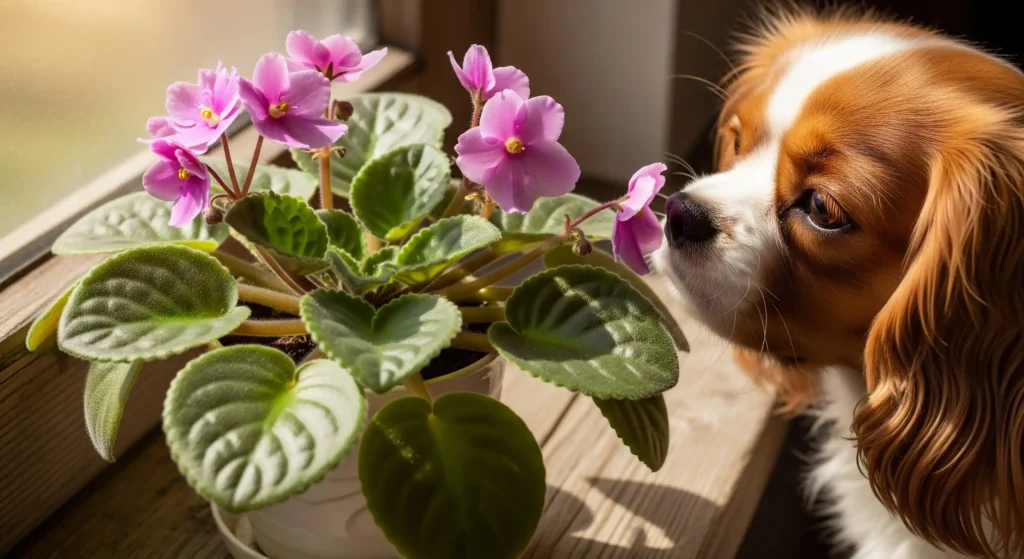
- Why It’s a Pet Parent’s Friend: These fuzzy-leaved plants are safe for cats and dogs, so you may enjoy their happy flowers without anxiety.
- Light Needs Made Easy: African violets like strong, indirect light. A window that faces east is often best. Fluorescent grow lamps can also help them grow. Stay out of the sun while it’s hot.
- Watering Wisdom (The Don’t-Panic Guide): Here is where they can be a little picky. Give them water when the top of the soil feels a little dry to the touch. To keep the fuzzy leaves from becoming wet, it’s best to water from the bottom. You can do this by putting the pot in a saucer of water for about 30 minutes, or until the soil surface is damp. Use water that is at room temperature.
- Soil and Potting Tips: Use a light, permeable potting mix made just for African violets. They like to be a little pot-bound.
- Fun Facts and Styling Tips: With the right care, they can bloom virtually all year long! They look great on windowsills, little shelves, or as a bright touch on a desk.
- Quick Keywords: African Violet pet safe, non-toxic African Violet, Saintpaulia care, and pet-friendly blooming plants.
How to Make a Plant Paradise That Is Safe for Pets
Choosing plants that are safe for pets is the most important thing, but here are some other things you can do to make sure your pets and your new plants get along:
- Placement is important: These plants are safe, but you might still want to keep them out of reach so your dog doesn’t use your Areca Palm as a chew toy or your cat doesn’t think your Boston Fern is a new place to snooze (which could hurt the plant!). Think of using elegant hanging planters, robust plant stands, or high shelves.
- Gently stop them from chewing or digging:
- Make sure your pets have lots of their own toys to gnaw on, places to scratch, and activities to keep them busy.
- If your cat likes to dig, putting some pretty (and smooth-edged) pebbles or bigger river rocks on top of the dirt can keep them from doing it. Some people say that putting citrus peels (cats usually don’t enjoy the smell) around the pot can help, but you should change them out often.
- Pay attention to how your pet acts. Some pets don’t care about plants at all, while others see every new leaf as a chance to play. Knowing how your pet acts will help you choose the right venue and plan.
- Introduce New Plants Slowly: Give your pets time to get acquainted to any new plants you introduce. Watch over their first meetings.
- What to Do If You Think Your Pet Ate a Plant (Even a “Safe” One): The plants on this list are not hazardous, but if your pet eats a lot of any plant material, it could cause moderate stomach discomfort, including vomiting or diarrhea, in certain pets that are sensitive. If your pet consumes part of a plant and you see any strange signs or are worried, you should always call your vet for help.
How to Always Check whether a Plant is Safe for Pets, Beyond the List
This list is a great place to start, but you could come across more plants that interest you. How can you find out if they’re safe for your pets?
- The ASPCA’s Toxic and Non-Toxic Plant List (which is easy to find online) is the best and most useful resource. You can browse through a large database they have. Other well-known animal welfare or veterinary groups may also have comparable lists.
- Botanical Names Are Important: The names of plants can be very confusing and change from place to place. There are a lot of plants with the name “Lily.” Some are safe, while others, like Easter Lilies or Peace Lilies (which don’t cause systemic poisoning but do irritate), are highly bad for pets, especially cats. To get the most accurate information about how poisonous a plant is, always try to find out its scientific (botanical) name. It frequently has two italics words, like “Chlorophytum comosum” for “Spider Plant.”
- If you’re not sure, assume it’s not safe (or keep it out of reach). If you can’t discover credible information that a plant is safe, it’s best to either not bring it into your home or make sure your pets can’t get to it.
In conclusion, have a beautiful home full of happy, healthy pets!
Look! A home with lots of plants and happy, healthy dogs can definitely go together! All you need is some knowledge and the appropriate green friends. The best houseplants that are safe for pets and don’t contain any harmful chemicals that we’ve looked at today come in a wide range of colors, textures, and styles. This shows that you don’t have to give up on looks to keep your pets safe.
So go ahead and pick up a few new leafy companions from our safe list. Your home will become a lively haven for everyone, both two- and four-legged! Making this peaceful place is quite satisfying. Happy planting and happy pets!
Your Quick Questions About Pet-Safe Greenery Answered!
Are succulents safe for animals?
It’s a blend! Some succulents, like the Haworthia Zebra we talked about, are widely thought to be safe, but many others are not. These include Echeverias and Sempervivums (Hens and Chicks). Some plants, like Jade Plants (Crassula ovata) and Aloe Vera, can be bad for pets. Before you bring a succulent home, it’s important to check the ASPCA list or another trusted source to see what kind it is.
My cat or dog ate a leaf from a plant that is “safe,” and now they seem a little strange. What should I do?
If a plant is labeled as “non-toxic,” it suggests that it shouldn’t make you really sick. However, if a pet eats a lot of any plant material or has a certain sensitivity, they may suffer moderate stomach problems like vomiting or diarrhea. If your pet eats any plant, even one that is “safe,” and they feel sick, or if you are ever worried, it is always better to keep an eye on them and call your doctor for guidance.
What are some nice houseplants that are tall or big and safe for pets?
The Areca Palm and a mature Money Tree (Pachira aquatica) from our list can both grow very big and be great floor plants that are safe for pets. Some bigger types of Boston Ferns can also make a big impact. If you want to find additional big plants, always check to see if the one you’re interested in is safe.
Is it safe to grow herbs inside with pets?
Most pets can safely eat tiny amounts of common cooking herbs including basil, rosemary, thyme, sage, and cilantro. But some herbs can be bad for some animals or in high amounts. For example, parsley isn’t very poisonous, but too much of it can be bad for some pets, and oregano oil can be annoying. It’s usually a good idea to look up the exact herbs you want to plant.
How can I keep my cat from using my plant pots as a bathroom?
Ah, a common problem for cats! One of the best ways to do this is to make the soil surface hard to get to or not very appealing. You may try putting a layer of smooth, pretty river rocks or bigger stones on top of the dirt. Some people have luck with pot covers that are made just for that purpose, or even by putting a piece of aluminum foil or a spiky (but safe) plastic mat (like a ScatMat, cut to size) on the ground for a short time until the cat loses interest. It’s also important to keep their real litter box clean and pleasant to them at all times!
Sources
To ensure the accuracy and scientific rigor of this guide, the information presented is supported by reputable veterinary and scientific organizations, as well as peer-reviewed research. We encourage readers to consult these resources for further in-depth knowledge.
- ASPCA Animal Poison Control Center (APCC) – Toxic and Non-Toxic Plants Database
- Description: The definitive resource for identifying plants toxic and non-toxic to pets, based on extensive case data and veterinary expertise.
- URL: https://www.aspca.org/pet-care/animal-poison-control/toxic-and-non-toxic-plants
- Specific Plant References (as cited in the article):
- Money Tree (Pachira aquatica): https://www.aspca.org/pet-care/animal-poison-control/toxic-and-non-toxic-plants/money-tree
- Spider Plant (Chlorophytum comosum): https://www.aspca.org/pet-care/animal-poison-control/toxic-and-non-toxic-plants/spider-plant
- Boston Fern (Nephrolepis exaltata): https://www.aspca.org/pet-care/animal-poison-control/toxic-and-non-toxic-plants/boston-fern
- Prayer Plant (Maranta leuconeura): (Note: ASPCA lists Maranta insignis as non-toxic, which is a common synonym or closely related species to Maranta leuconeura for toxicity purposes) https://www.aspca.org/pet-care/animal-poison-control/toxic-and-non-toxic-plants/calathea-lancifolia-2 (This link specifically refers to Calathea Lancifolia but the general Maranta family is covered as non-toxic by ASPCA).
- Rattlesnake Plant (Calathea lancifolia): https://www.aspca.org/pet-care/animal-poison-control/toxic-and-non-toxic-plants/calathea-lancifolia-2
- Areca Palm (Dypsis lutescens): https://www.aspca.org/pet-care/animal-poison-control/toxic-and-non-toxic-plants/areca-palm
- African Violet (Saintpaulia spp.): https://www.aspca.org/pet-care/animal-poison-control/toxic-and-non-toxic-plants/african-violet
- Haworthia (Haworthia spp. or Haworthiopsis spp.): (General Haworthia species are listed as non-toxic by ASPCA, though not a specific page for H. attenuata or H. fasciata).
- Milewski, L. M., & Khan, S. A. (2006). An overview of potentially life-threatening poisonous plants in dogs and cats.
- Journal: Journal of Veterinary Emergency and Critical Care, 16(1), 25-33.
- Description: A peer-reviewed article discussing the toxicity of common poisonous plants known to cause serious systemic effects or death in dogs and cats, based on ASPCA APCC data.
- URL: https://www.cabidigitallibrary.org/doi/full/10.5555/20063058911
- Wikifarmer – Pet-Safe Indoor Plants: How to Create a Green Home Without Risk
- Publication Date: May 22, 2025
- Description: An article providing an overview of popular non-toxic houseplants, including care tips and pet safety information.
- URL: https://wikifarmer.com/library/en/article/pet-safe-indoor-plants-how-to-create-a-green-home-without-risk
- Aerosphere Monitoring, LLC – The Best Air-Purifying Plants Safe for Children, Cats, and Dogs
- Description: Discusses the benefits of indoor plants for air quality and lists hypoallergenic, pet-safe options.
- URL: https://aerospheremonitoring.com/blogs/news/the-best-air-purifying-plants-safe-for-moms-and-babies
- ResearchGate – (PDF) Poisoning plants in cats and dogs
- Authors: (Multiple authors, typically listed on the PDF itself)
- Description: A review discussing various plants that can pose a danger to cats and dogs, their properties, and treatment options.
- URL: https://www.researchgate.net/publication/379308678_Poisoning_plants_in_cats_and_dogs
- Frontiers for Young Minds – How Do Plants Protect Themselves Against Animal Attacks?
- Publication Date: January 9, 2024
- Description: An accessible article explaining plant defense mechanisms against herbivores, indirectly supporting the concept of animal-plant interaction.
- URL: https://kids.frontiersin.org/articles/10.3389/frym.2023.991723
- Gardenia.net – Haworthia: Best Varieties, Care and Grow Guide
- Description: Provides information on Haworthia species, including their non-toxic status.
- URL: https://www.gardenia.net/genus/haworthia-best-varieties-care-grow-guide
- The Planty Blog – Is Maranta Lemon Lime Toxic to Cats?
- Description: Discusses the non-toxicity of Maranta plants to cats, while also advising caution regarding ingestion of large quantities or chemicals used on plants.
- URL: https://theplantyblog.com/is-maranta-lemon-lime-toxic/
- Lively Root – Calathea Plants and Pet Safety: Toxicity Concerns for Cats and Dogs
- Description: Confirms the non-toxicity of Calathea plants to pets and provides advice on preventing ingestion.
- URL: https://www.livelyroot.com/blogs/plant-care/calathea-plants-toxicity
- Noggins & Binkles – What Houseplants Are Safe for Cats – Pets, Plants and Purification
- Publication Date: January 21, 2019
- Description: A blog post discussing various pet-safe houseplants, including Areca Palm and Spider Plant.
- URL: https://www.nogginsandbinkles.com/blogs/tails/what-houseplants-are-safe-for-cats-pets-plants-and-purification
- Pawious – Protect Your Plants: Effective Strategies to Stop Dogs from Eating Them
- Publication Date: March 15, 2024
- Description: An article discussing reasons for dogs eating plants and strategies to deter them, including physical barriers and natural repellents.
- URL: https://pawious.com/blogs/learning-and-helpful-information/protect-your-plants-effective-strategies-to-stop-dogs-from-eating-them
- Plantology USA – Spider Plants and Cats: Navigating the Myth of Toxicity
- Publication Date: January 31, 2024
- Description: Debunks the myth of spider plant toxicity to cats, citing reputable sources.
- URL: https://plantologyusa.com/blogs/the-plantologist/are-spider-plants-poisonous-to-cats


